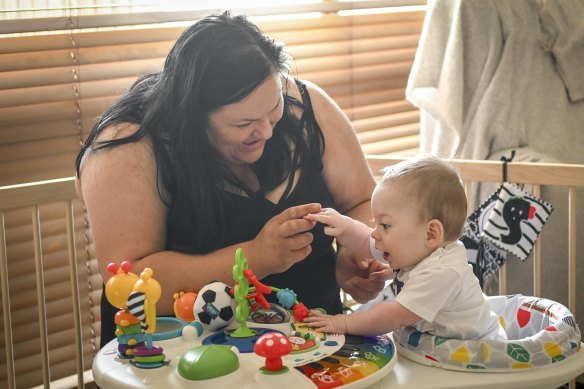House prices blamed for Australia’s lowest birth rate on record
By Shane Wright and Lachlan Abbott
High housing costs and the expense of bringing up children have been blamed for a collapse in the number of babies born across Australia as the nation’s fertility rate tumbled to its lowest level since the early days of European settlement.
Nationally, there were 286,998 births through 2023 – the fewest since 2006. It was a 4.6 per cent drop, or almost 14,000 fewer births, than the number of births in 2022.
The fall meant the nation’s fertility rate fell to its lowest level on record of just 1.5. The fertility rate – the average number of children born to a woman over her lifetime – has now dropped a quarter since its most recent peak recorded in 2008.
The epicentre of the collapse is Sydney where the number of births has slumped by 14 per cent since 2018, coinciding with a 50 per cent increase in the city’s median house price.
It’s little better in Melbourne where the number of births has fallen by 10 per cent since 2018 despite the city being home to an extra 300,000 residents.
The inner-city areas of every capital, including Adelaide, Brisbane, Perth and Hobart, now have fertility rates below 1 with neighbouring suburbs also showing steep declines.
The only areas with fertility rates above 2.1 – considered to be the population replacement level – are all in rural and regional country areas.
Not only are total births and the fertility rate falling, the median age of parents continues to climb to record highs. The oldest mothers in the country are in Canberra and Victoria at 31.9 years while the median age for fathers has climbed to 34.3 years in the ACT.
Fertility rates by age are falling, with large drops for women in their 20s. The only age cohort with an increase in fertility is women aged between 45 and 49 who make up a tiny share of total births.
Australian National University demographer Liz Allen said generations of inaction by politicians and institutions had delivered the nation’s young people a bleak future.
“We have young people who say they want to have a child, or a subsequent child, but the barriers in front of them are insurmountable. The rug is being pulled from beneath their futures,” said the demographer.
“Housing affordability, economic insecurity, gender inequality and climate boiling – that’s a recipe for the most effective contraceptive ever.”
Total births peaked in 2018 when 315,147 children were born across the country. Since then, total births have dropped by almost 9 per cent.

Jessica Paulo wondered how she could afford a baby before she had her son, Deejay, who was born six months ago. Credit: Eddie Jim
Jessica Paulo was 11 weeks pregnant when she discovered a baby was on the way.
One worry stood out: “How will I afford it?”
Paulo said on Wednesday: “If I’m barely keeping myself alive, how am I going to keep a little human alive?”
Six months ago, her son, Deejay, was born. The pair live on a single-parent pension in Melbourne’s outer-eastern suburb of Rowville, where the fertility rate has fallen by 20 per cent over the past decade.
Jessica, 33, said she was “really lucky” to have good family and friends around to help care for Deejay when required, but money remained tight.
“Now that I do have one [child], I know I definitely couldn’t afford another,” she said.
AMP chief economist Shane Oliver said the increasing cost of housing was contributing to couples making a “rational” decision to either not start a family or have fewer children.
“People make a decision looking at the relative cost of a child or starting a family, and what that means, and comparing that to what they could spend the money on if they don’t,” he said.
“Couples look at the cost of trying to get into the housing market and then make a rational decision to compare that against consuming that money differently.”
Countries across the world have been introducing policies to boost fertility rates with almost none succeeding.
In Hungary, the government offers discounted loans and grants to heterosexual couples that have families while mothers who have at least four children escape personal income taxation for life. Despite these initiatives, the fertility rate is continuing to fall.
South Korea this year recorded the lowest fertility rate in the world at just 0.72 with forecasts its population could halve over the next half century. Governments have introduced a range of policies including monthly payments to mothers, but this has failed to arrest the decline.
Oliver said while the Costello-era baby bonus had an initial small impact, it had failed in the longer term to turn around Australia’s fertility rate.
He said given the experience of the baby bonus and other countries, throwing more money at the issue may not succeed.
Earlier this year, Treasurer Jim Chalmers said he supported people having more children but rejected reintroducing the baby bonus.
At 1.5, the fertility rate is well below the latest federal budget forecast which is predicated on a fertility rate of 1.64.
Sixty per cent of births were to couples in marriage, an institution also in decline. The national marriage rate, after a spike following the end of COVID-19 restrictions, fell to its lowest level on record in 2023.
The number of births would have been lower but for an increase in children born to Indigenous mothers. Aboriginal and Torres Strait Islander registered births increased by 349 babies, accounting for 8.6 per cent of all births in 2023.
Cut through the noise of federal politics with news, views and expert analysis. Subscribers can sign up to our weekly Inside Politics newsletter.